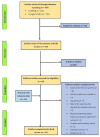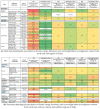Diet Quality, Nutritional Adequacy and Anthropometric Status among Indigenous Women of Reproductive Age Group (15-49 Years) in India: A Narrative Review
- PMID: 37637490
- PMCID: PMC7614979
- DOI: 10.3390/dietetics2010001
Diet Quality, Nutritional Adequacy and Anthropometric Status among Indigenous Women of Reproductive Age Group (15-49 Years) in India: A Narrative Review
Abstract
In India, indigenous communities are nutritionally vulnerable, with indigenous women suffering the greater burden. Studies and surveys have reported poor nutritional outcomes among indigenous women in India, yet systematic documentation of community-specific nutrition data is lacking. We conducted a narrative review of 42 studies to summarise the nutritional profile of indigenous women of India, with details on their food and nutrient intakes, dietary diversity, traditional food consumption and anthropometric status. Percentage deficits were observed in intake of pulses, green leafy vegetables, fruits, vegetables, flesh foods and dairy products when compared with recommended dietary intakes for moderately active Indian women. Indices of diet quality in indigenous women were documented in limited studies, which revealed poor dietary diversity as well as low consumption of diverse traditional foods. A high risk of nutritional inadequacy was reported in all communities, especially for iron, calcium, and vitamin A. Prevalence of chronic energy deficiency was high in most communities, with dual burden of malnutrition in indigenous women of north-eastern region. Findings from this review can thus help guide future research and provide valuable insights for policymakers and program implementers on potential interventions for addressing specific nutritional issues among indigenous women of India.
Keywords: Indian tribal women; diet quality; dietary intake; food consumption; indigenous women; nutrient intake; nutritional status.
Conflict of interest statement
Conflicts of Interest: The authors declare no conflict of interest. The funders had no role in the design of the study; in the collection, analyses, or interpretation of data; in the writing of the manuscript; or in the decision to publish the results.
Figures




References
-
- Kuhnlein HV, Erasmus B, Spigelski D, Burlingame B. In: Indigenous Peoples’ Food Systems & Well-Being: Interventions & Policies for Healthy Communities. Food and Agriculture Organization of the United Nations, McGill University, editor. Food and Agriculture Organization of the United Nations: Rome, Italy; Centre for Indigenous Peoples’ Nutrition and Environment; Ste-Anne-de-Bellevue, QC, Canada: 2013. ISBN 978-92-5-107433-6.
-
- [accessed on 29 September 2019];Census of India Website: Office of the Registrar General & Census Commissioner, India. 2011 Available online: http://censusindia.gov.in/
-
- World Bank. India: Food Security and Nutrition in Tribal Areas. World Bank; Washington, DC, USA: 2014.
-
- Ministry of Tribal Affairs, Government of India. [accessed on 14 June 2020]. Available online: https://tribal.nic.in/
-
- Ministry of Tribal Affairs. Annual Report 2021–2022. Ministry of Tribal Affairs, Government of India; New Delhi, India: 2022.
Grants and funding
LinkOut - more resources
Full Text Sources
